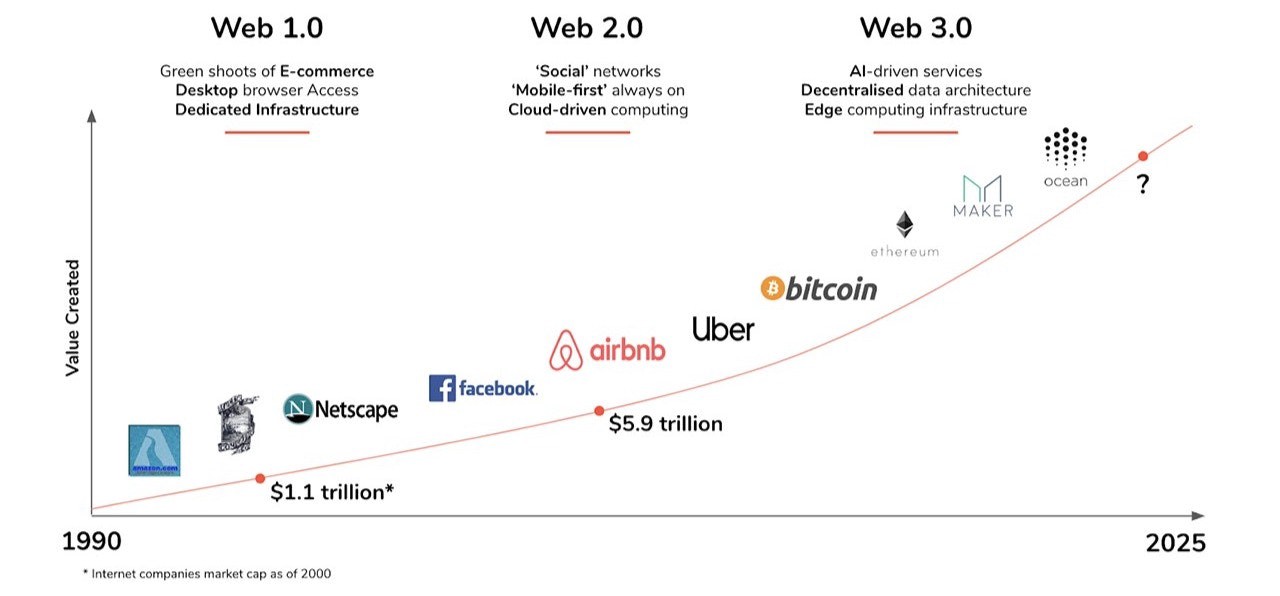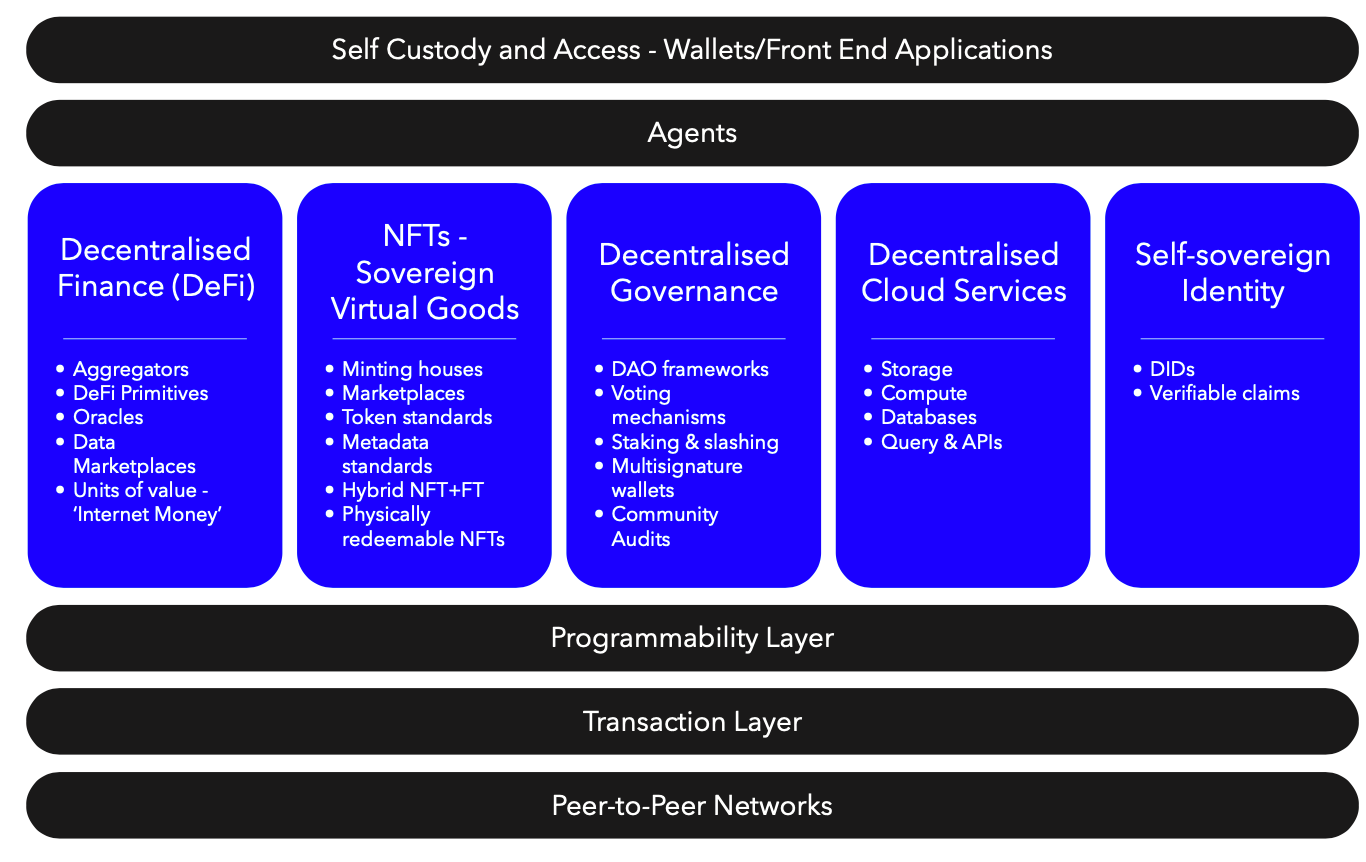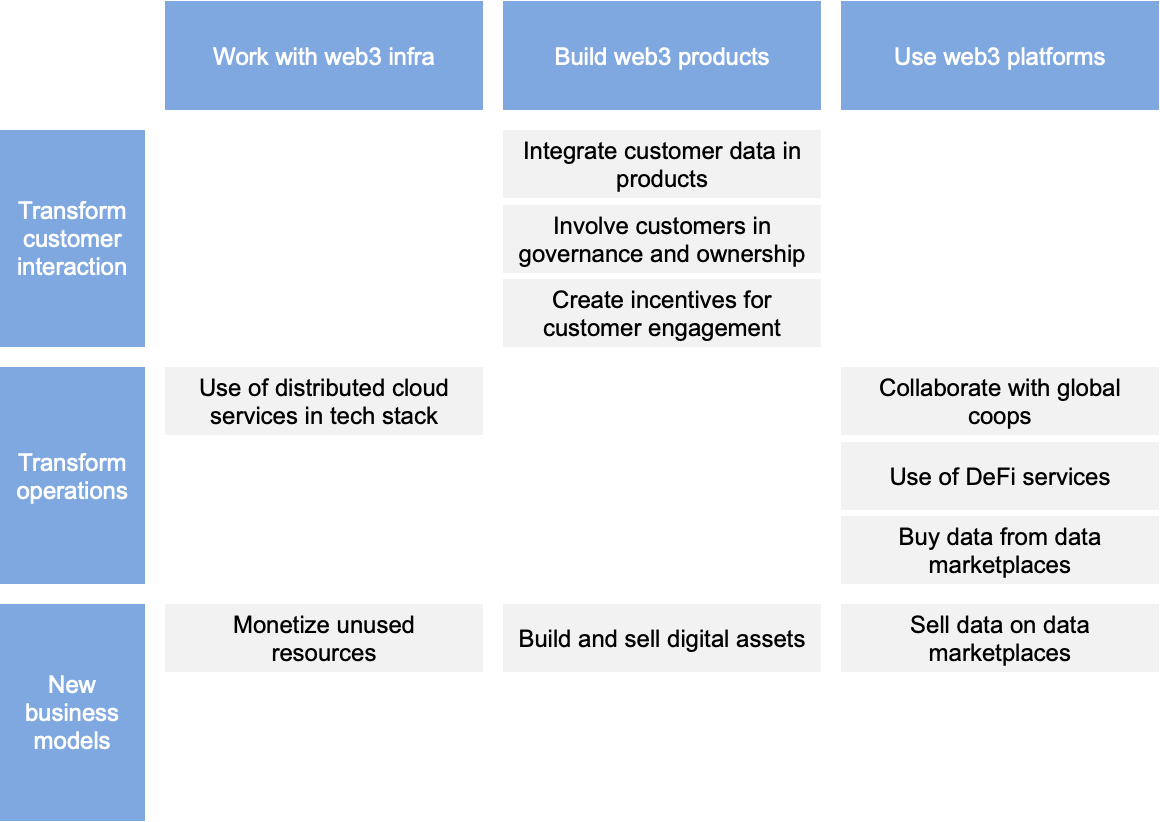摘要: Current solutions and business opportunities from using web3 technologies.
With an expected market size of 1.25t, digital transformation is the defining business opportunity of our time. The current key themes are closely linked: The metaverse reimagines the frontend, web3 the backend of the web. On web3, there is little insight from a business perspective. Why is it relevant, what solutions exist already, and what are the business opportunities?
- Web3 is a new technology foundation of the web. It is meant to remediate monopolist structures and enable digital asset ownership.
- Solutions for web3 infrastructure, apps, and platforms have been built for almost a decade. Some have already reached significant adoption.
- For businesses, web3 creates opportunities to transform customer interactions, operations and build new business models.
First Fortune500 corporations started taking those opportunities. It would be negligent for businesses to ignore them. Therefore, it is crucial to understand what they are and how they can be taken.
Why is Web3 Relevant?
Digital transformation is both a huge business opportunity and one of the main societal shifts of our time. It is expected to reach a global market size of 1.25t by 2026. It already makes up for 15.5.% of global GDP but grows 2.5x faster.
The Web is probably the most important enabler of digital transformation. Today, we’re using what is called web2. Compared to web1 before, it made interactive apps, user-generated content, and free-to-use access popular. Web2 business models are typically based on using network effects to achieve market dominance, and monetizing user data through e.g. advertising. Web2 companies such as Google, Facebook, Apple, and Amazon have huge market shares in their respective segments.

▲Figure 1: Illustrated journey from web1 to web3(來源:Fabric Ventures)
Current trends indicate a shift away from those structures. As more consumers are digitally native, they want to reclaim agency and keep ownership of their digital creations. Emerging technologies such as blockchain, AI, and extended reality enable new types of solutions. Businesses invest in digital twins and need to cope with virtual work and the Great Resignation. And regulation such as Europe’s GDPR and DMA is increasing emphasis on user agency.

▲Figure 2: Web3 definition(來源: Chris Dixon of a16z)
The major themes of this shift are the metaverse and web3 movements. They are two sides of the same coin, creating a new front- and backend of the Web. Where metaverse uses new tech like extended reality and AI to create new ways of digital interaction, web3 is using blockchain and tokenization to build a more distributed data layer into the internet that allows for ownership of digital goods.
The metaverse movement might be the driver, but web3 is the needed enabler to overcome web2 limitations that are stifling innovation. As business models’ success is based on market dominance, web2 suffers from monopolist structures and mis-use of power.
Consumers are locked into walled gardens. They cannot move digital goods between platforms. Personal data is at risk of being misused by companies and governments as shown in the Cambridge Analytica and PRISM/Snowden scandals. And consumers are at the mercy of providers who can exclude them from services without means to appeal.
Businesses are similarly impacted. Platforms providers can limit competitors access to markets. They collect tolls from others’ value creation and unilaterally set the rules. And they can use their power to takeover of others’ businesses. The Apple Appstore and Amazon marketplace offer plenty of inspiration for examples.
Web3’s vision is the improve this situation. For consumers, this would be a move from walled gardens to interoperability, from at-risk privacy to data ownership, and from de-platforming risk to censorship resistance. For businesses, it would be a move from closed to open markets, from value extraction to value ownership, and from market domination to competition and collaboration.
If you want to imagine web3’s vision, just imagine you could sign in anywhere without having to create a user account with any service. Imagine you could control who can access any of your personal data, and how they can use it. And imagine you could earn ownership of a platform that succeeds because of your content.
Where is Web3 Today?
There are components on three layers of web3 that are currently being built: Web3 infrastructure, applications and platforms.
Web3 infrastructure components use principles of peer-to-peer networks with integrated monetary incentives to realize transaction / programmability layers and decentralized cloud services.
Web3 applications combine creating standards with inherent user empowerment to realize self-sovereign identity and decentralized governance solutions.
Web3 platforms build on platform business models, but with collaborative ownership to realize self-sovereign market places, global cooperatives / consortia, and build ecosystems.

▲Figure 3: Framework for web3 infrastructure and applications(來源:Outlier Ventures)
Infrastructure components for the transaction / programmability layer are being developed since 2013. Smart contract platforms such as Ethereum, BSC, Solana, or Cosmos provide the technical foundation. Build on them, stablecoins such as USDT, USDC, or DAI allow for US dollar-denominated financial transactions. And NFT standard provide the technical foundation for digital goods.
Decentralized cloud services for storage such as IPFS or Filecoin are being developed since 2015. Their services are being used, but they are not yet at a price point competitive to web2 solutions. Decentralized compute services are being developed.
Self-sovereign identity apps exist in form of digital wallets such as Metamask, Trust Wallet, or Keplr. They achieved adoption and are used to interact with existing web3 platforms. E.g. Metamask surpassed 20m monthly active users in 2021. Newer projects such as Spruce try to expand web3 login to any website. Name services such as ENS allow to select easy to use wallet names similar to email addresses.
Personal data management solutions such as from Inrupt are being developed to allow users to control their identity, data, and how it is shared with websites. Data is stored in “Personal Online Data Stores” (Pods). Websites and apps can interact with Pods and access data they need for certain tasks when granted permission.
Decentralized governance toolkits such as Aragon allow to set up and manage the software constitution of digital cooperatives in so-called Decentralized Autonomous Organizations (DAOs).
Platforms that operate self-sovereign marketplaces have reached mass adoption since 2020. Decentralized digital currency exchanges such as Uniswap, Sushiswap, or Pancakeswap operate on levels similar to the biggest centralized exchanges. Borrowing / lending marketplaces such as Compound or Aave manage 20b of assets. Data marketplace Ocean protocol contains >600 data sets and offers functionality for privacy-preserving data analysis.
Web3 cooperatives in form of DAOs have become popular in the last years. Friends with benefits has been set up as a social club with newsletter, city guides, and a Discord group. PleasrDAO and Flamingo pool funds for speculating on digital goods. VentureDAO and TempleDAO are venture-capital investment groups. And projects such as Molecure or VitaDAO fund and foster collaboration in life sciences research.
Incorporating self-sovereign market places and web3 cooperatives, whole ecosystems have been emerging. Decentralized Finance (DeFi) comprises peer-to-peer financial services for e.g. savings, lending, exchanges, trading, and derivates. It grew to a >200b segment in the past years. Decentralized AI (DeAI) projects are building tools for data scientists outside the big tech environments. And Decentralized Science (DeSci) is building community-organized science operations.
How Can Businesses Benefit From Web3?
Some businesses are already working with web3. High fashion brands such as Gucci started to sell virtual fashion. Digital art sales came into the spotlight with Beeple’s First 5000 Days sold for almost 70m at Christies. Sports clubs such as Manchester City are creating fan tokens to incentivize engagement. Bayer build its TraceHarvest solution for tracking produce from seed to supermarket on web3 tech. And Microsoft is building enterprise services and invested in the creator of Metamask.
Business can think about how web3 might create new opportunities to transform customer interactions, operations, and enabling new business models. Likewise, they can think about opportunities from using web3 infrastructure, building web3-enabled products, and using web3 platforms.

▲Figure 4: Web3 business opportunities framework(來源:uxdesign.cc)
New types of customer interactions can primarily be created by building web3-enabled products. Personal data could be integrated into a product while preserving privacy and therefore increasing users’ willingness to share. Products could be created that are governed by its users, giving them a say in product decisions, or even making them co-owners of the product. And token models such as fan tokens might be used to incentivize brand engagement.
Opportunities to transform operations can be found using web3 infrastructure and platforms. Businesses could use distributed cloud services in their tech stack where their benefits outweigh the costs, e.g. for massive distributed computing. They could collaborate with web3 cooperatives, include DeFi services in treasury processes, and shop on data marketplaces for analytics projects.
New business opportunities can be found across. They might monetize unused compute/storage resources in distributed cloud service networks. They could build and sell digital goods similar to what high fashion companies are already doing. And they could sell data on data marketplaces without comprising their intellectual property.
What to Make of Web3 Criticism?
Web3 has vocal opponents, with Jack Dorsey of Twitter and Moxie Marlinspike of Signal among the most prominent ones. Packy McCormick makes a very good argument against their views. Most criticism of web3 is not addressing shortcomings of the concept itself, but of the current landscape. On this subject however, criticism is not without reason.
Critics point out that web3 in not decentralized but rather dominated by few solutions and companies such as Alchemy, Infura, OpenSea, Coinbase, and Binance. While market leaders exist, the technology’s openness continues to encourage challengers. Progressive decentralization will likely come with growing market maturity.
They point out that costs are too high compared to web2 solutions. This is true for the current situation, but ignores scale. With growth, economies of scale will make them more cost-competitive.
They emphasize negative side effects of operating blockchain technology such as consuming a lot of energy and facilitating crime. This is at least disputed by the web3 community. It might not be that bad when compared with the existing financial industry, and is also expected to improve with new innovations.
Others point out decentralized solutions already exist but never achieved adoption. One of the differentiating innovations of web3 is its integrated incentive mechanism. This changes chances of adoption significantly.
When limitations of blockchain technologies such as low compute capacities and append-only storage are mentioned, it is typically a misunderstanding of web3. Not everything in web3 needs to run on blockchain technology. It it good for a specific purpose and web3 uses it for this.
Some critics are afraid that e.g. online harassment, hate speech, or child abuse might become even more difficult to police. This is another misunderstanding of web3. It doesn’t prevent moderating institutions. Source data might not be censored, but it can be excluded from showing up in front-ends. Which is not that different than today.
A lot of web3 solutions are currently owned by venture firms. A common criticism therefore is that it replaces current unequal power structures with new ones. This might be true for the current generation of solutions. Projects needed funding before web3 was broadly known. The next generation of solutions is in a much better negotiation position.
In summary, web3 is a still maturing sector that will improve on some of the current issues. For other issues, current solutions might be adjusted and continue to be used. Yet other issues might remain. Eventually it’s a trade-off between benefits and drawbacks. Just like it always is.
Conclusion
Looking at metaverse developments and web2’s shortcomings, there is an obvious need for web3. An already striving sector is creating foundational technology, infrastructure, applications, and platforms. It provides opportunities that would be negligent for businesses to ignore. There is valid criticism of the current market landscape, but not on a level that would invalidate the concept itself.
Looking ahead, successful solutions will most likely not be following any doctrine. Everything being fully decentralized and owned by users exclusively isn’t practical. There will still be room for centralized elements such as supporting organizations, something referred to as “web2.5”.
As with every innovation, it will likely follow the innovator’s dilemma trajectory. At first, niche use cases can succeed where web3’s benefits matter most and its shortcomings don’t matter as much. With growth, economies of scale will help achieve competitiveness in other aspects. And eventually it will consolidate its position in the framework of the internet.
From a business perspective, data opportunities seem to be under-leveraged at the moment. They can be found across all dimensions of the introduced framework, yet there is little traction across industry to realize them. An interesting follow-up question would be how a web3 network for data collaboration in a specific industry could look like.
轉貼自Source: uxdesign.cc
若喜歡本文,請關注我們的臉書 Please Like our Facebook Page: Big Data In Finance


留下你的回應
以訪客張貼回應